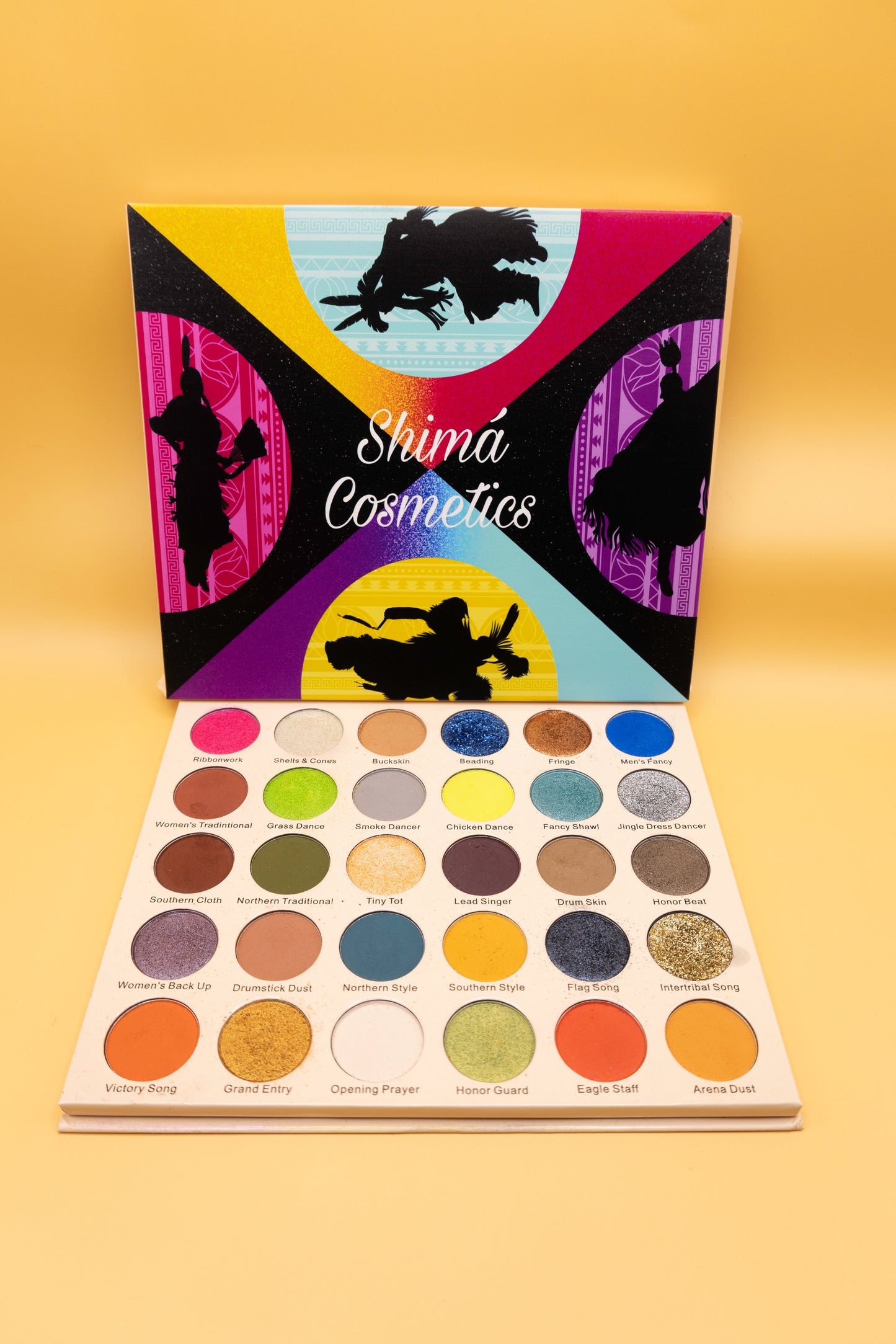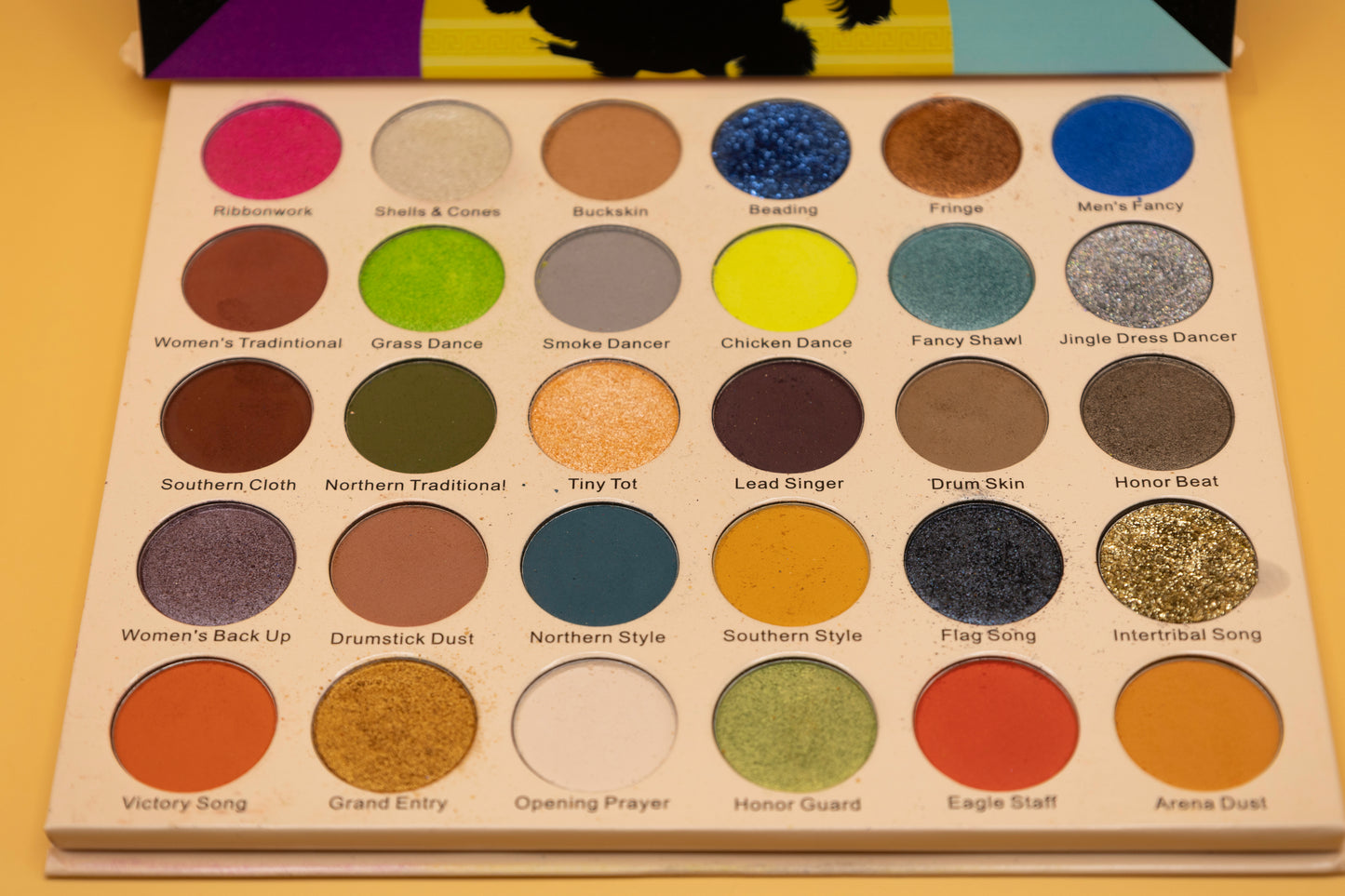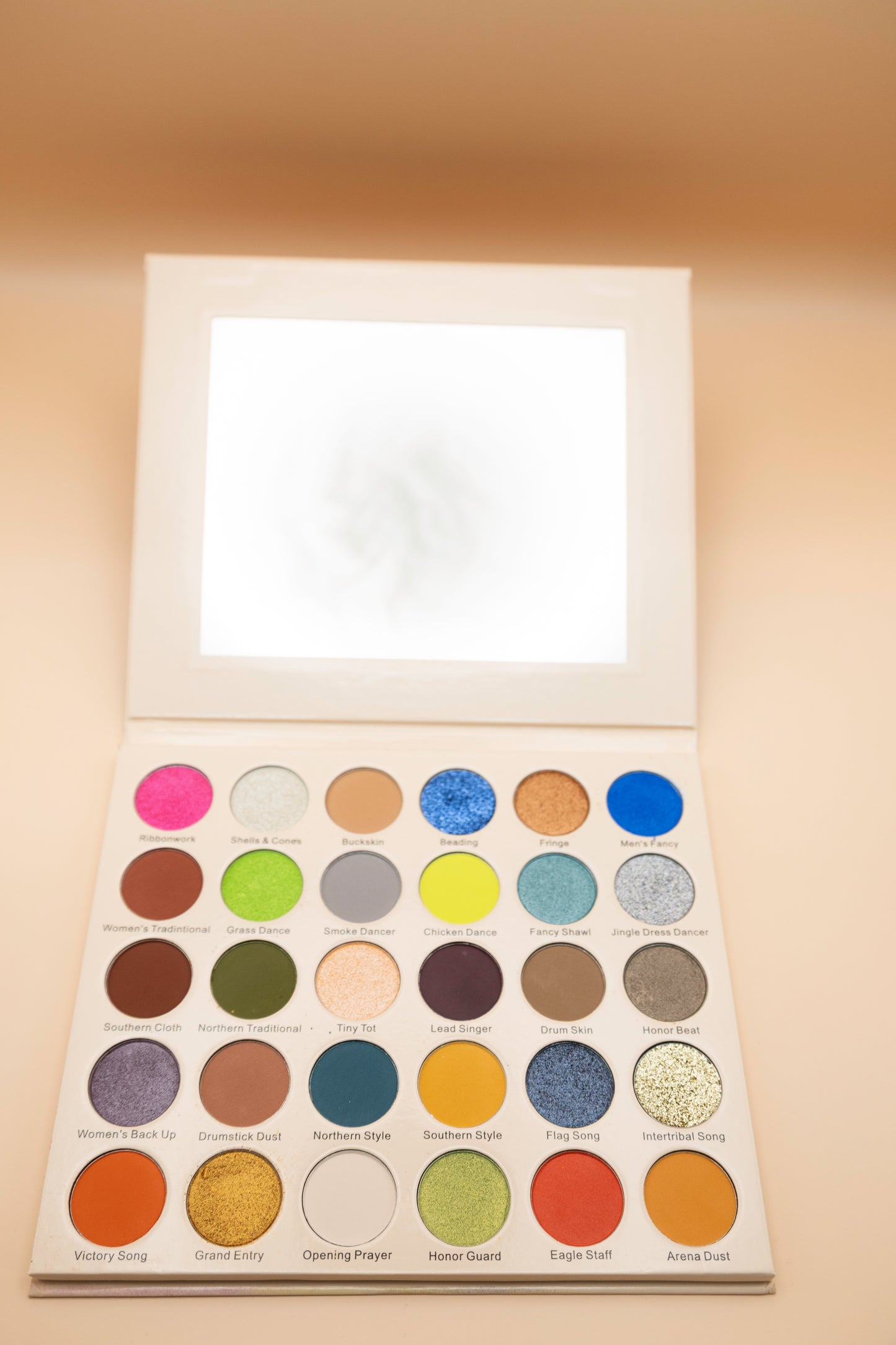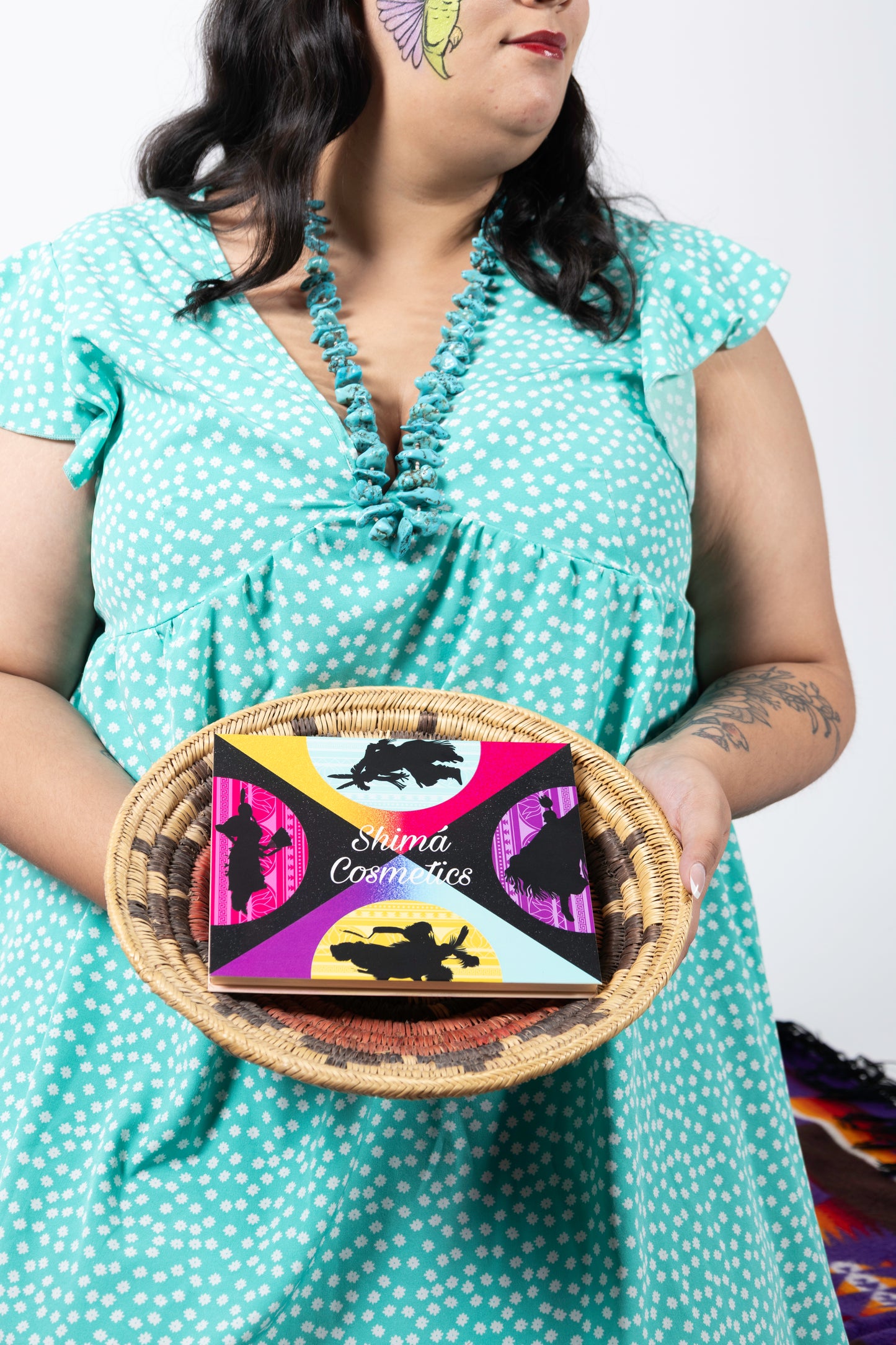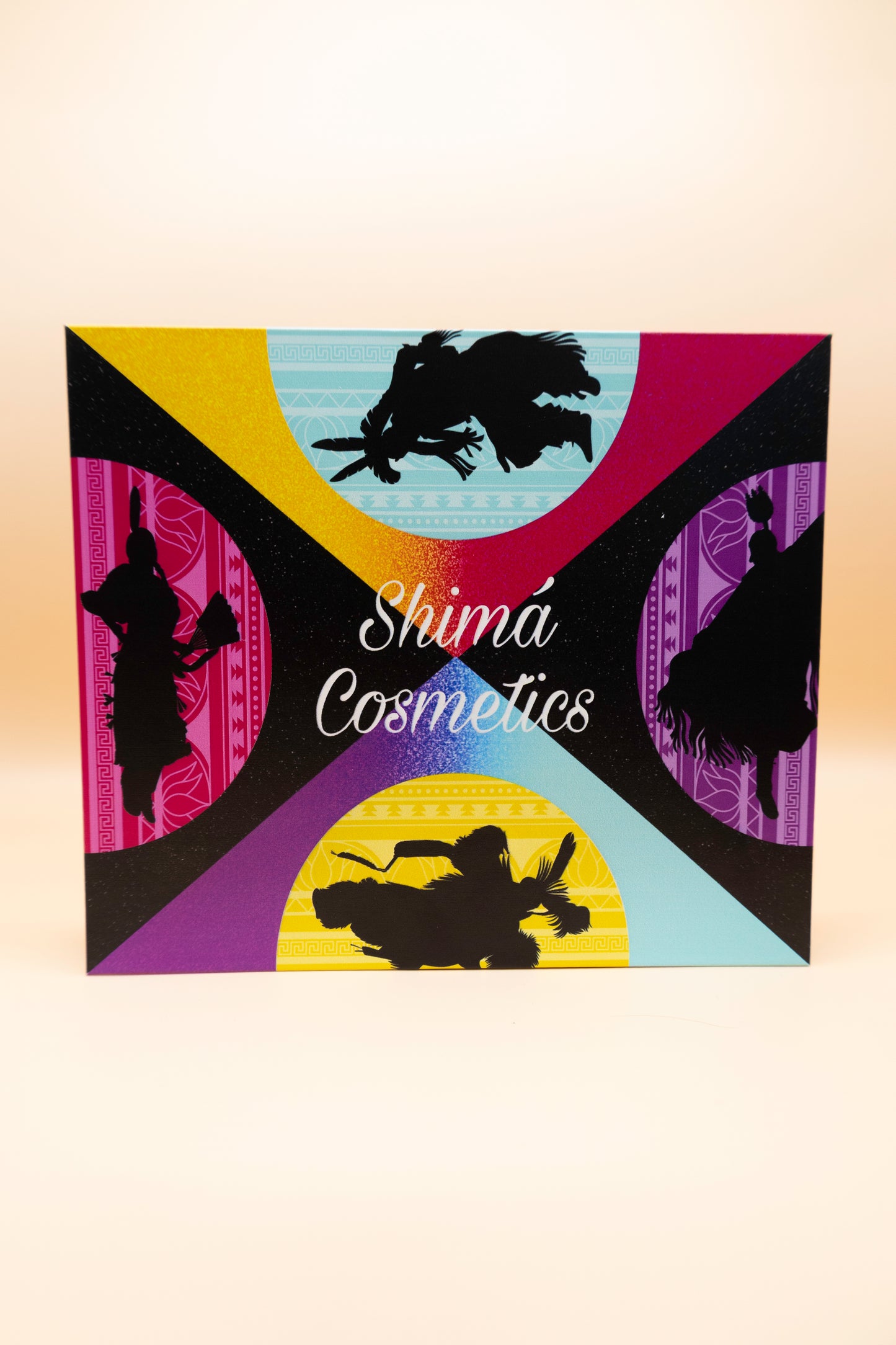Shima Cosmetics
Pow Wow Palette
Pow Wow Palette
Couldn't load pickup availability
Story
Story
Pow Wow Palette
Row 1: Regalia and Tradition
Ribbonwork
Meaning: Bright ribbons sewn into skirts and shawls symbolize prayers, beauty, and identity. The colors often represent family or tribal heritage.
Performance: When dancers move, the ribbons ripple like waves of light — prayers set in motion for all to see.
Feeling: Radiant and flowing, carrying prayers in motion.
Shade: Vivid multicolor shimmer.
Shells & Cones
Meaning: From jingles to shells, these adornments are living prayers, each sound offered for healing and joy. The jingles on a dress originated as medicine for the people.
Performance: As the dancer steps, the jingles sing. Every note is a prayer rising into the circle.
Feeling: Healing, joyful, and full of movement.
Shade: Silver metallic with sparkle.
Buckskin
Meaning: Tanned hide has clothed and protected Native people for centuries, often decorated with beadwork and paint. It connects people to land and tradition.
Performance: Buckskin regalia moves with grace, grounding the dancer with dignity and strength.
Feeling: Earthy, steady, and protective.
Shade: Matte sandy beige.
Beading
Meaning: Each bead carries a prayer. Patterns tell stories of identity, heritage, and survival, passed down across generations.
Performance: When beadwork shines in the light of the arena, it is more than decoration — it is the voice of ancestors stitched into beauty.
Feeling: Sacred, intricate, and full of memory.
Shade: Metallic turquoise-blue.
Fringe
Meaning: Flowing strands represent the connection between air, earth, and spirit. They make prayer visible.
Performance: Every swing of fringe mirrors wind and grass, creating a dance between the human body and the natural world.
Feeling: Airy, graceful, and free.
Shade: Golden yellow shimmer.
Row 2: The Dancers I
Men’s Fancy Dance
Meaning: Fancy Dance emerged in the early 1900s as a competitive style, but for Native communities it represents strength, survival, and modern expression of identity. It shows that tradition can evolve while staying connected to spirit.
Performance: Dancers wear twin feather bustles and bright neon regalia, often with arm bustles and ribbonwork. Movements are extremely fast, with high jumps, spins, and footwork that demand athleticism and stamina.
Feeling: Explosive, daring, and powerful.
Shade: Neon rainbow shimmer.
Women’s Traditional
Meaning: This dance represents dignity, respect, and the role of women as carriers of strength and prayer.
Performance: Women move slowly and gracefully, often holding a fan, shawl, or blanket. Their steps are deliberate, with a proud upright posture, sometimes rocking gently side-to-side to mimic walking in prayer.
Feeling: Grounded, prayerful, and elegant.
Shade: Matte soft taupe.
Grass Dance
Meaning: Originating from the Northern Plains, this dance symbolized flattening the grass for new camps. Spiritually, it represents balance, healing, and harmony with the land.
Performance: Regalia is covered in long fringe that flows like grass in the wind. Dancers move with side-to-side sways, bends, and fluid footwork, imitating the natural motion of the plains.
Feeling: Flowing, healing, and balanced.
Shade: Matte grassy green.
Smoke Dance
Meaning: Rooted in the Haudenosaunee (Iroquois) traditions, the Smoke Dance reflects the quick, unpredictable movement of fire and smoke. It is both ceremonial and highly competitive.
Performance: Movements are fast and intricate with quick spins, stomps, and sudden directional changes. Dancers mimic the rising, swirling nature of smoke with precision and intensity.
Feeling: Fierce, fiery, and alive.
Shade: Shimmering charcoal gray.
Chicken Dance
Meaning: From the Blackfoot and other Plains tribes, this dance tells the story of prairie chickens during mating season, representing alertness and warrior spirit.
Performance: Dancers wear feather bustles styled like prairie chickens. They move with light, precise steps, puffing out their chests and bobbing their heads in bird-like rhythms.
Feeling: Playful, sharp, and spirited.
Shade: Matte warm brown.
Row 3: The Dancers II
Fancy Shawl Dance
Meaning: Known as the “butterfly dance,” Fancy Shawl represents transformation and the beauty of young women in motion. It is sometimes seen as a celebration of womanhood and new beginnings.
Performance: Women wear shawls with long fringe that spread like wings. They spin, twirl, and dance with quick footwork, imitating butterflies in flight.
Feeling: Light, bright, and transformative.
Shade: Neon fuchsia shimmer.
Jingle Dress Dance
Meaning: Originating with the Ojibwe people, the Jingle Dress is a healing dance. Each jingle cone represents a prayer for health and well-being.
Performance: Dresses are adorned with hundreds of rolled metal cones that make a jingling sound with every step. Dancers move in a steady, bouncing rhythm, creating music and prayer as they circle.
Feeling: Healing, steady, and joyful.
Shade: Metallic silver-blue.
Southern Cloth
Meaning: A Southern Plains women’s dance style, Southern Cloth represents grace, tradition, and the continuity of women’s roles in ceremony and community.
Performance: Women wear cloth dresses with belts and sashes, moving in steady, dignified steps with poise and elegance.
Feeling: Elegant, timeless, and strong.
Shade: Matte deep maroon.
Northern Traditional
Meaning: This men’s dance reflects warrior traditions and honors hunters, veterans, and storytellers. It is a dance of survival and respect.
Performance: Dancers wear feather bustles, beadwork, and breastplates. Their movements are deliberate, powerful, and often tell stories of the hunt or battle.
Feeling: Strong, proud, and steady.
Shade: Matte deep navy.
Tiny Tot
Meaning: Tiny Tot dances honor children as the future of Native communities. Seeing them in regalia is a joyful reminder that traditions are alive and carried forward.
Performance: Children dance in miniature regalia, often imitating the steps of their parents. Their dances are playful, filled with joy, and deeply meaningful to families and the circle.
Feeling: Joyful, bright, and hopeful.
Shade: Soft pastel pink matte.
Row 4: Drum Circle
Lead Singer
Meaning: The Lead Singer begins the song, carrying the first voice that awakens the heartbeat of the drum. They guide the circle, ensuring the prayer takes shape.
Performance: Just as a single voice can move mountains, the lead sets the tone, giving strength and direction to the song.
Feeling: Commanding, bold, and guiding.
Shade: Rich matte red.
Drum Skin
Meaning: The hide stretched across the drum represents Mother Earth herself. Every strike echoes her heartbeat, reminding us we are walking upon her body.
Performance: Soft yet powerful, the drum skin is the voice of the earth, resonating through the arena and binding the people together.
Feeling: Deep, grounding, and strong.
Shade: Matte warm tan.
Honor Beat
Meaning: Honor Beats are accented strikes when the heartbeat of Mother Earth is acknowledged. Dancers raise their fans or pause, showing respect to ancestors, warriors, and the spirit world.
Performance: Each Honor Beat is like a sacred pulse, reminding the circle that the dance is prayer and gratitude in motion.
Feeling: Sacred, reverent, and strong.
Shade: Bronze shimmer.
Women’s Back Up
Meaning: The women’s backup singers lift their voices behind the drum, representing the heartbeat of life and creation itself. Their voices weave around the men’s leads, completing the circle of song.
Performance: They are the echo of Mother Earth’s heartbeat, adding harmony and beauty to every song. Without them, the drum would not be whole.
Feeling: Harmonious, nurturing, and supportive.
Shade: Soft lavender shimmer.
Drumstick Dust
Meaning: Each strike of the drumstick is like a step in time — connecting past, present, and future. The wear and dust left behind carry the memory of countless songs and dances.
Performance: The rhythm never dies. The dust is proof that the heartbeat of Mother Earth has been honored again and again.
Feeling: Timeless, enduring, and spiritual.
Shade: Matte dusty brown.
Row 5: Pow Wow Songs
Northern Style
Meaning: Originating from the Plains and Great Lakes, Northern Style singing is sharp, high-pitched, and carried in the falsetto. For Native people, these voices pierce the sky, reaching the spirit world.
Performance: Songs begin high, then descend like a prayer carried by the wind. The tone is urgent, powerful, and meant to awaken the circle with energy.
Feeling: High, piercing, and prayerful.
Shade: Icy sky blue shimmer.
Southern Style
Meaning: From the Southern Plains, this style carries deep, resonant voices that echo like thunder. It represents strength, community, and the grounding presence of the drum.
Performance: Southern songs rise and fall in full-bodied tones, steady and rich. They embody balance — the deep heartbeat of Mother Earth paired with human voice.
Feeling: Thunderous, resonant, and grounding.
Shade: Deep matte forest green.
Flag Song
Meaning: Sung to honor veterans, warriors, and the flags they carried, the Flag Song is a moment of solemnity. It’s often considered as sacred as a national anthem in the pow wow circle.
Performance: Everyone stands still, many with heads bowed, as the song honors sacrifice and survival. Its steady rhythm is both prayer and tribute.
Feeling: Solemn, strong, and proud.
Shade: Metallic silver-gray.
Intertribal Song
Meaning: Intertribals are songs for everyone, no matter their tribal nation. They are unifying, welcoming, and joyful, inviting all into the circle.
Performance: With catchy, uplifting melodies, Intertribal Songs fill the arena with movement. The drum calls out, and people answer by dancing together as one.
Feeling: Welcoming, joyful, and bright.
Shade: Neon coral matte.
Victory Song
Meaning: Once sung for warriors returning home, Victory Songs today celebrate resilience, survival, and the endurance of Native people.
Performance: Strong and triumphant, this song lifts hearts. It is a declaration of pride — that despite hardships, the people are still here, still dancing, still singing.
Feeling: Triumphant, proud, and enduring.
Shade: Matte bold red.
